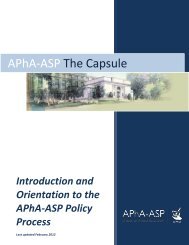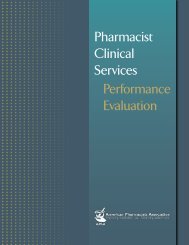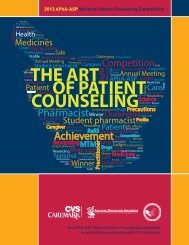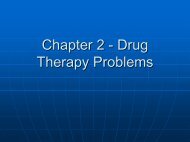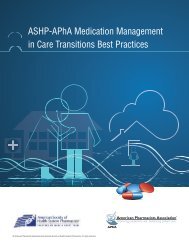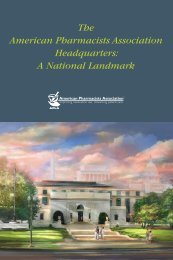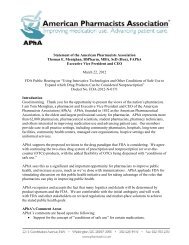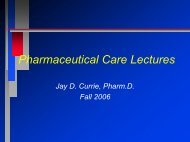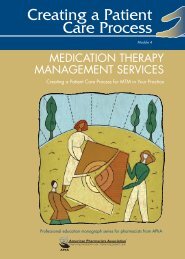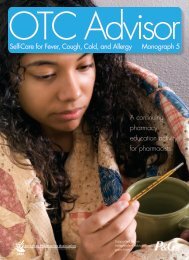Community Pharmacist Preceptor Education Program - Library
Community Pharmacist Preceptor Education Program - Library
Community Pharmacist Preceptor Education Program - Library
- No tags were found...
Create successful ePaper yourself
Turn your PDF publications into a flip-book with our unique Google optimized e-Paper software.
knowledge bases and can be extremely valuable for thosewho have management aspirations for any pharmacysetting.Student pharmacists should be introduced to severaldifferent elements of operations. 15 Understanding thefactors that lead to a pharmacy’s financial success isimportant. You may want to review the pharmacy’soperating statements with student pharmacists to givethem a global view of the pharmacy’s finances. Othertopics for discussion may include sources of income,revenue, and profit margins. Some student pharmacistsmay have a particular interest in learning how prices forprescription drugs are established. (However, be sure toheed any confidentiality agreements that affect discussionof pricing specifics.)Inventory management is another key element of sitemanagement. Explain your ordering system, inventorymanagement, stock rotation, and management of financialtransactions with various suppliers.Promoting ProfessionalismFostering professionalism in student pharmacists andsocializing student pharmacists to the pharmacy workethic is an essential component of any pharmacy rotation,even if it is not explicitly stated in the goals and objectivesof the rotation.Professionalism is a broad concept that has beendefined many ways, including:■ “Displaying values, beliefs and attitudes that putthe needs of another above your personal needs.” 16■ “Setting and maintaining standards of competenceand integrity and providing expert advice to societyon matters of health.” 17■ “The extent to which an occupation or a memberof that occupation exhibits the characteristics of aprofession.” 18The Code of Ethics for <strong>Pharmacist</strong>s describes aspectsof professionalism that are specific to the profession ofpharmacy (Figure 3). 19Many activities can be used to cultivate an attitude ofprofessionalism in student pharmacists during rotations.For example, preceptors could develop a learning activitybased on the Code of Ethics for <strong>Pharmacist</strong>s. Studentpharmacists could be asked to discuss the code with thepreceptor and/or write an essay about what the Code ofEthics for <strong>Pharmacist</strong>s means to them.However, the attitudes and behaviors that you andyour staff display during the rotation will likely leavea more lasting impression than any verbal or writtenstudent activity. 20 Because of your status as a mentorand role model, your actions, and those of the entirepharmacy staff, may have implications for the studentpharmacist’s attitudes and behaviors for their entirecareer.Effective role modeling is as important to teachingprofessionalism as it is to teaching any other skill. Forexample, even if you profess the importance of compassionatepatient care, if student pharmacists observe youor other staff members display an attitude of exasperationtoward certain patients, that behavior is what your studentpharmacists will learn. In addition to ensuring that yourinteractions with the student pharmacist are respectful,never make belittling comments about patients or otherhealth care providers.Another component of developing professionalism isfostering attitudes of continuous professional developmentand involvement. The practice of pharmacy andpharmacologic management of diseases and promotion ofwellness is constantly evolving. Professionalism requirespharmacists to be committed to lifelong learning to monitornew research and trends affecting the patient populationsthat they serve. Participation in continuing educationactivities is an important step toward maintainingcompetency for practitioners and preceptors. <strong>Pharmacist</strong>sshould review literature associated with the profession inaddition to pursuing their individual practice interests. Youmay want to discuss with your student pharmacist theactivities that you engage in to remain abreast of clinicalissues, and possibly involve him or her in the activities.Professionalism includes a commitment to stayingcurrent with changes in rules and regulations governingthe practice of pharmacy. 21 Discuss with your studentpharmacist the issues that you see as important to theongoing development of the profession of pharmacy (e.g.,the growth of patient care services; payment for MTMservices; government and other third-party payer policiesthat affect reimbursement for prescription costs anddispensing fees). Explain the importance of such issuesto student pharmacists, and discuss how the landscape ofthe pharmacy profession is constantly changing. Nurturepositive attitudes toward the value of the pharmacist as amember of the health care team and of pharmacy to publichealth and welfare. Discuss the importance of pharmacistshaving a strong voice to explain the value of pharmacy topatient care and public health.Pharmacy associations and groups promote thevalue of pharmacy for public health and advocate forgovernmental policies that support this value. You maywant to discuss your association affiliations and thebenefits of membership, as well as some of the activitiesof those organizations and why you believe they areimportant to pharmacists and pharmacy. Ask the studentpharmacist about his or her association involvement andencourage membership and ongoing commitment. Ifyou work for a pharmacy chain that has a governmentaffairs department, you can use this opportunity toeducate student pharmacists about the activities of thatdepartment and their importance to the profession.Use Worksheet 6 to reflect on what professionalismmeans to you and how you can promote professionalismin your student pharmacists.20 APhA and NACDS Foundation



